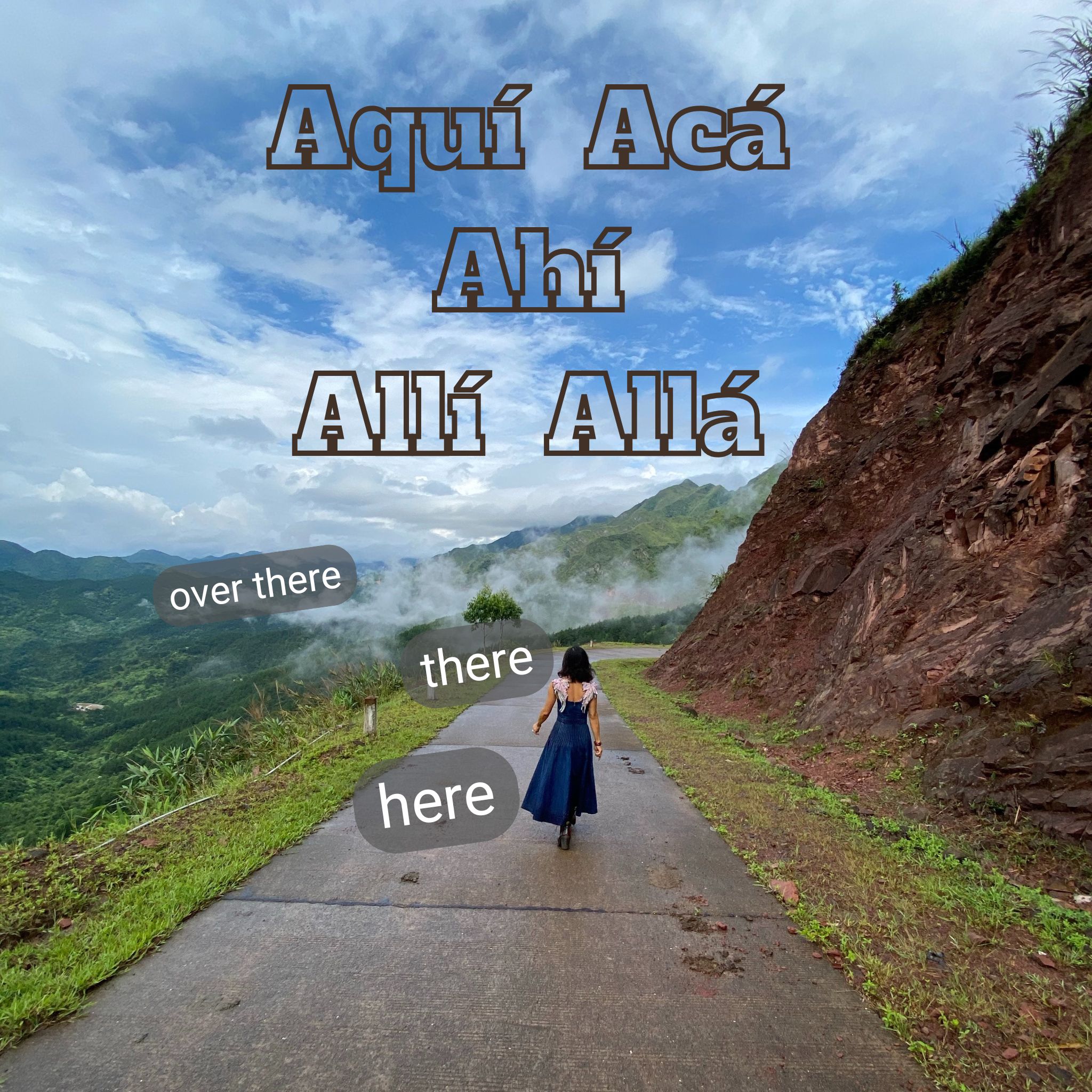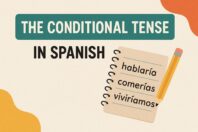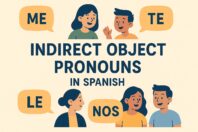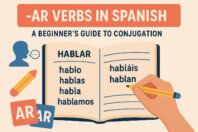Here, There, and Over There in Spanish: Acá vs Aquí vs Ahí vs Allí vs Allá

Get our free email course, Shortcut to Conversational.
Have conversations faster, understand people when they speak fast, and other tested tips to learn faster.
More infoWhen we want to express a location or where something takes place, we use adverbs of place or location. In today’s post we are going to cover the Spanish location words for here, there and over there. In Spanish we have five equivalents that we’ll introduce here: acá vs aquí vs ahí vs allí vs allá.
In English, you have two distances: here and there. In Spanish we have three: here, there and over there.
For learners, it might be tricky getting to know when to use each adverb in Spanish, since these Spanish adverbs are more specific than their English counterparts. In this post we’ll cover each of our Spanish location words in turn to clear up all the ambiguities around here and there in Spanish.
The three scales of distance: Here, There, and Over there in Spanish
To start off, let’s first see our five Spanish location words based on distance. Don’t worry, in the following sections we’ll go through the differences between aquí vs acá, and allí vs allá.
| Here | Aquí, Acá |
| There | Ahí |
| Over there | Allí, Allá |
Note that all these adverbs have an accent mark on the final vowel.
In our explanations here, we’ll consider that these distances correspond to close, near, and far. We’ll give more details when discussing each word in their respective sections below.
By close, we’re talking about things which are essentially adjacent to the speaker. For both aquí and acá, an English speaker would say “here.” We can also consider temporal closeness for when something is happening right now. By close we mean right here, right now.
By near, we’re talking about things which are generally within sight of the speaker, but not so close to touch. Often, the things are close to the person being addressed. In English, the speaker would therefore say “there” rather than “here.” Temporally, we’re considering a time not too far off.
By far, we’re referring to things which are more distant. These can be within view but which need to be pointed at to clarify (hence our general translation of “over there,” even if you can often simply say “there” in English), or they can be so far that the speaker needs to refer to the place (like if we say “over there in Japan”). When talking about time, we’re referring to a long time ago in the past.
Other Spanish location words
Before we get into the details of our different options for here and there in Spanish, let’s see the other set of Spanish location words which use the same scales of distance: the demonstrative adjectives. If you’re familiar with the three options for this and that in Spanish, the same three distances apply when choosing between the different options for here and there in Spanish.
For a deeper explanation of the demonstrative adjectives in Spanish, check out our simple guide to este, ese, and aquel. For now, we’ll just include this table as an easy reference comparing the demonstrative adjectives Spanish uses, with the Spanish adverbs of place we’re covering in this post:
| Demonstrative adjectives: Spanish – English | Adverbs of place: Spanish – English |
| Este/Esta, Estos/Estas – This, These | Aquí, Acá – Here |
| Ese/Esa, Esos/Esas – That, Those | Ahí – There |
| Aquel/Aquella, Aquellos/Aquellas – That, Those | Allí, Allá – Over there |
Here: Aquí and Acá
We have two words for here in Spanish: aquí and acá. When we’re referring to distance, we use both in similar circumstances to talk about something close to the speaker. There are slight differences when we’re referring to time. Each also exists within specific idiomatic expressions.
Aquí
Aquí is used to express a specific location near the speaker.
- Look, your rings are right here. – Mira, tus anillos están aquí.
- People here love animals. – La gente aquí ama a los animales.
- Come here to study. – Ven aquí a estudiar.
On a temporal scale, aquí denotes a specific starting time. Depending on the context, the translation can often be “as of this point.”
- So far so good. – Hasta aquí, todo bien.
- He won the lottery. From then on, his life changed completely. – Ganó la lotería. Desde aquí, su vida cambió por completo.
Aquí and allá work together in this idiomatic expression, de aquí para allá, whose literal translation is “from here to there”:
- We were running to and fro the whole morning. – Estuvimos corriendo de aquí para allá toda la mañana.
Acá
Acá is also used to talk about a location or area near to the speaker. When choosing between acá vs aquí, acá is generally less specific.
- My grandparents must have walked down here when they were young. – Mis abuelos deben haber caminado por acá cuando eran jóvenes.
- You can rent a house here in Patagonia. – Puedes alquilar una casa acá en la Patagonia.
- There’s nobody here. – Acá no hay nadie.
On a temporal scale, we use the construction of de [a specific moment] acá or desde [a specific moment] acá to mean from [a specific moment] up to now. It’s just necessary to say when the time period started, as in this example where it was yesterday – ayer:
- My cat was outside from yesterday up to now. – Mi gato estuvo afuera de ayer acá.
Acá and allá work together in this idiomatic expression, de acá y de allá, implying many indeterminate places.
- I’m from here and there. – Soy de acá y de allá.
Acá vs aquí
We saw the differences between acá and aquí when talking about time: aquí is used as a specific starting point of our stories, roughly translated with “as of this point,” whereas acá is used as an ending point of whatever we’re talking about, generally translated with “up to this point.”
As for the differences between aquí vs acá when talking about location, the choice of which word for here in Spanish basically comes down to regional preferences. In Latin America, acá is often used more often, even when talking about specific locations.
- Here at home, we love drinking mate. – Acá en mi casa, nos encanta tomar mate.
In Spain, on the other hand, acá is less common and is normally used to add a level of vagueness to the location.
- I don’t recognize which house, but I think my parents lived here when I was born. – No reconozco en qué casa, pero creo que mis padres vivían acá cuando nací.
In Spain acá is also regularly used with the preposition para to express movement to here.
- He must come [to] here as soon as he can. – Que venga para acá cuando pueda.
There: Ahí
We use ahí to say there in Spanish, when something is near but not immediately within reach of the speaker.
- Leave the book there on the table. – Deja el libro ahí sobre la mesa.
- I put the letter there. – Puse la carta ahí.
- Hello! Is anybody there? – ¡Hola! ¿Hay alguien ahí?
- We have to take the children there, to the room next door. – Tenemos que llevar a los niños ahí, al cuarto de al lado.
Por ahí is a specific idiomatic construction using ahí which has a meaning of its own. Rather than trying to translate the words together, por ahí rather needs to be taken as a whole to denote a certain vagueness. When talking about a place, por ahí can be translated as around there.
- I’ll hang around there for a while. – Me voy por ahí un rato.
Por ahí is also used in general speech to simply mean maybe. In this sense, por ahí just adds a general level of uncertainty to whatever we’re describing, unrelated to any location.
- Maybe he didn’t like what you said. – Por ahí no le gustó lo que dijiste.
Ahí vs allí
As we just saw, ahí is used to refer to people or things near to the speaker, usually translated simply as there. We’ll go into more detail on allí in the next section, used to refer to people or things at a much greater distance, best translated as over there.
The other confusing factor when looking at allí vs ahí is that they both sound almost the same! There’s no denying that you’ll likely find it difficult to differentiate one from the other when listening to spoken Spanish, so you’ll often need to rely on the context to understand if the speaker is referring to something nearby or farther away.
In your own Spanish pronunciation, try to say ahí slightly faster than you pronounce allí. Allí sounds longer, with a definite “y” sound separating the two vowel sounds.
Over There: Allí and Allá
Allí and allá are the Spanish words for there, both indicating that the person or thing we’re referring to is quite far from the speaker. It’s a good idea to think of the translation of allí and allá as over there. However, since the context is often enough to indicate the distance, the translation is often simply there in English.
Allí
We use allí to indicate something far from the speaker. It can be used both as in that place over there and to that place over there.
Here are a few examples using allí as “in that place over there,” all of which generally translate simply as over there in English:
- Martin met Julieta over there. – Martín conoció a Julieta allí.
- Over there, there is another beach. – Allí hay otra playa.
- He told me we could buy a house over there in Mérida. – Él me dijo que podíamos comprar una casa allí en Mérida.
Here are a few examples using allí as “to that place over there,” which again translate simply to there or over there in English:
- The group will go there by the end of the summer. – El grupo irá allí sobre el fin del verano.
- We’ll get there, to the Middle East, soon. – Pronto llegaremos allí, al Oriente Medio.
Allá
Like allí, we use allá to refer to something or someone located far away from the speaker. In general, we choose allá over allí to add an element of vagueness if we’re talking about an imprecise location.
- Over there we have the mystery novels. – Allá tenemos las novelas de misterio.
- They got there by foot. – Llegaron allá caminando.
- Your bike is still over there, downtown. – Tu bicicleta está siempre allá en el centro.
- My friends stayed over there in Tokyo. – Mis amigos se quedaron allá en Tokio.
When we use allá to talk about time, it refers to a long time ago in the past.
- We would always come to Buenos Aires, long ago in my childhood. – Siempre veníamos a Buenos Aires, allá en mi niñez.
Allá figures in a handful of idiomatic expressions that have their own meaning beyond their literal translations. We already saw de acá y de allá in our section on acá. Here are a couple of others:
- If you don’t go to university, it’s your problem. – Si no vas a la universidad, ¡allá tú!
- Their relationship went beyond friendship. – Su relación fue más allá de una amistad.
Allí vs allá
Just like we saw above when comparing aquí vs acá, allí and allá are mostly interchangeable when we’re talking about far distances. A general rule of thumb is that we choose allá when we want to reduce the precision of whatever location we’re referring to over there, especially in Spain. When considering allá vs allí in Latin America though, allá is used more often than allí regardless of the precision.
- Juan lives six months here and six months there. – Juan vive seis meses acá y seis meses allá.
- Julia was on her way there when she ran into you. – Julia iba hacia allá cuando se encontró contigo.
Demonstrative Pronouns
So far in this post we considered our five words for here and there in Spanish as adverbs, which is definitely the primary grammatical role played by aquí, acá, ahí, allí and allá. In some informal circumstances, however, these same words can be used as pronouns to replace nouns in a sentence. Their use as demonstrative pronouns in Spanish remains quite informal, so we’re just including this use in case you come across such examples:
- This one here is going to speak. – Aquí va a hablar.
Conclusion
In this post we examined the Spanish adverbs of place: aquí, acá, ahí, allí, and allá. We saw that aquí and acá both translate as here, whereas the right Spanish word for there depends on the distance: ahí is used for near distances, while allí and allá refer to far distances and can often be translated as over there. To get a better understanding of the three distances, we compared these words for here and there in Spanish with the Spanish demonstrative adjectives: este, ese, and aquel.
As for the differentiation between aquí vs acá for here, and between allí vs allá for over there, acá and allá are generally the words of choice in Spain where there’s a degree of vagueness to the location. In Latin America, on the other hand, the choice really comes down to personal preference.
In addition to examining these adverbs for their use in referring to people or things at varying distances, we also saw how they can be used to talk about timeframes. We also learned several idiomatic expressions using each one. Finally, we acknowledged the informal practice of using these words as pronouns to replace nouns altogether.
Hopefully you’re now a lot more comfortable with the different Spanish words for here and there. To give your understanding a bit of practice, we’ll close this post with some exercises so you can give their use a try in context!
Exercises
Complete the following sentences by choosing between aquí, acá, ahí, allí, and allá.
1. Ven ______, quiero decirte un secreto.
2. Hace una hora que estoy en este lugar. Me dijo que nos encontraríamos ______.
3. Lo compré en esa tienda. Siempre compro cosas ______.
4. Mi madre nació en Buenos Aires. Ahora no vive más ______. Ahora vive ______ en Barcelona conmigo.
5. Aquel es el lugar. ______ vamos a construir la casa.
6. Fuimos por ______ porque no conocíamos otro camino.
7. ¿Ves aquella niña lejos? ______ encontrarás la puerta de salida.
8. No queremos volver a ese lugar. Mejor nos quedamos ______ en casa.
9. Este libro es el que debes leer. Déjalo ______ sobre esa mesa.
10. ______ en Argentina, nos encanta comer empanadas.
Answers
1. Ven aquí, quiero decirte un secreto. – Come here. I want to tell you a secret.
2. Hace una hora que estoy en este lugar. Me dijo que nos encontraríamos aquí. – I’ve been in this place for an hour. He told me that we will meet here.
3. Lo compré en esa tienda. Siempre compro cosas ahí. – I bought it in that store. I always buy stuff there.
4. Mi madre nació en Buenos Aires. Ahora no vive más allí. Ahora vive aquí en Barcelona conmigo. – My mother was born in Buenos Aires. She doesn’t live over there anymore. Now she lives here with me in Barcelona.
5. Aquel es el lugar. Allí vamos a construir la casa. – That is the place. We are going to build the house there.
6. Fuimos por allá porque no conocíamos otro camino. – We went over there because we didn’t know any other way.
7. ¿Ves aquella niña lejos? Allí encontrarás la puerta de salida. – Do you see that girl way over there? There you will find the exit door.
8. No queremos volver a ese lugar. Mejor nos quedamos aquí en casa. – We don’t want to go back to that place. We’d better stay here at home.
9. Este libro es el que debes leer. Déjalo ahí sobre esa mesa. – This book is the one you should read. Leave it there on that table.
10. Acá en Argentina, nos encanta comer empanadas. – Here in Argentina, we love eating empanadas.



